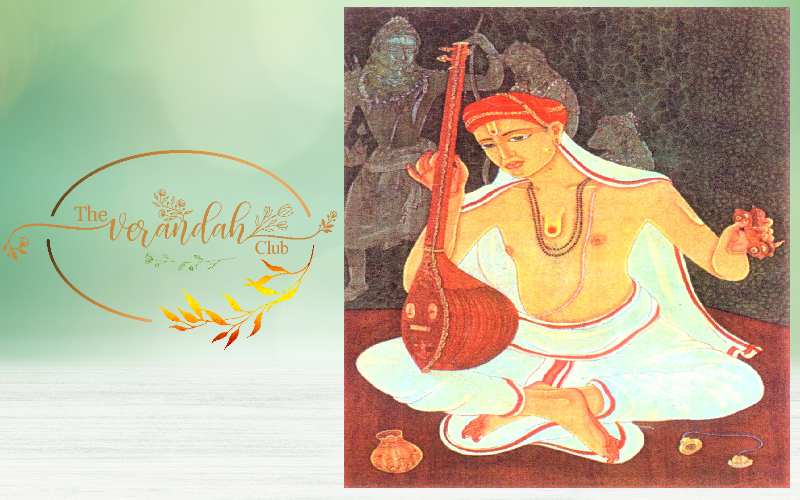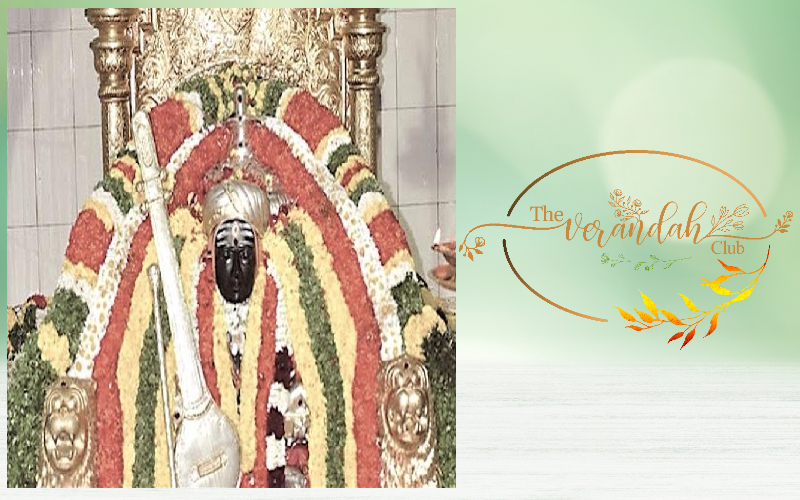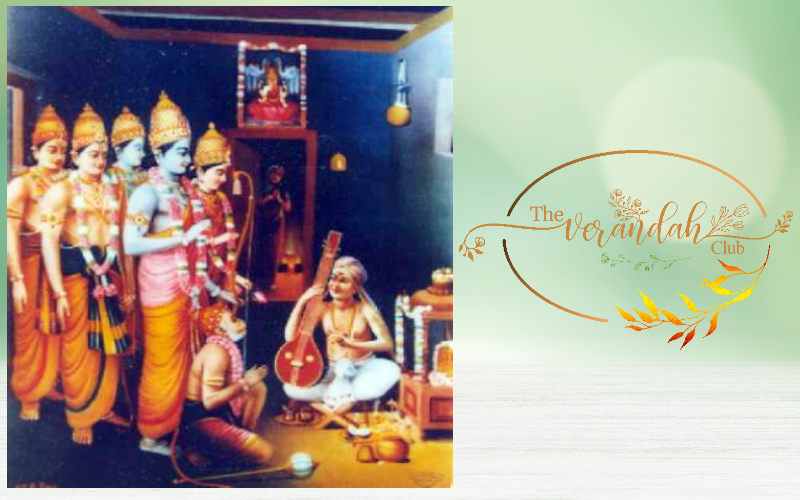
The Carnatic song, ‘Jagadānanda Kārakā’, was composed by Saint Tyāgarāja (1767-1847), the bard of Tiruvaiyāṛ, a small hamlet in the Tanjāvūr district. Tyāgarāja, also known as ‘Tyāga Brahmaṁ’ was a renowned composer of Carnatic music. Tyāgarāja along with his contemporaries, Śyāmā Śāstrī and Mutthuswāmī Dīkṣtar were regarded as the ‘Trinity of Carnatic Music’.
Tyāgarāja was a ‘Vaggeyakkāra’ (a composer who was capable of setting their songs to apt Rāga-s and also sing them). He had composed over 24000 devotional compositions of which only about precious 700 are available today. He was a prolific composer and had written songs mostly in Telugu, and in praise of Lord Rāma.
Even though, he had composed thousands of songs, 5 of his compositions were acclaimed as ‘Pañcaratna Kīrtanās’ (five gems) through which he had revealed not only his mastery over his musical techniques, but also his deep-rooted Bhakti towards his Iṣta Devatā (favorite God), Lord Rāma.
Many Rasikā-s were drawn to his Bhakti drenched musical, mellifluous compositions. One among them was Bangalore Nagarathnamma who donated all her wealth for the resurrection of the Samādī of Saint Tyāgarāja and built a shrine over it. She was also instrumental in initiating the ‘Tyāgarāja Utsavaṃ’ (a musical tribute).
This commemorative music festival, ‘Tyāgarāja Ārādhanā’, is celebrated annually in Tiruvaiyāṛ. It is celebrated during the months of January and February in his honor. On Puṣya Bahulā Pancamī, thousands of people and celebrated Carnatic musicians chorally sing the Pañcaratna Kṛtīs with the accompaniment of musicians who play the Vīna-s, Violins, Flutes, Nādasvaraṃ-s, Ghataṃ-s, Mṛdanga-s and various other instruments.

Jagadānanda Kārakā is the first Pañcaratna Kṛtī. The majestic aura of the Rāga, Naṭa has compelled the composer to choose this Rāga for his first ‘Ghaṇarāga Pañcaratna’ (a weighty Rāga which is suitable for improvisation). The Rāga Naṭa has an intoxicating melodious arrangement of notes which is becoming for this song. Naṭa Rāga is considered to be a Maṅgaḷa Rāga,(auspicious raga). This Rāga is generally sung in the early part of the concert. Innumerable artists commence their concert by singing a composition in this Rāga. Several songs in praise of Lord Gaṇeśa, such as ‘Mahāgaṇapatiṃ’ by Mutthuswāmī Dīkṣtar, ‘Ānanda Nartana Gaṇapatiṃ’ by Oothakaadu Venkatakavi are composed in this Rāga.
Some film songs such as ‘Panivizhum Malarvanam’, ‘Narumughaiye Narumughaiye’, ‘Vennila Vennila’, ‘Chennai Senthamizh’, ‘Iyengaru Veetu Azhagey’ are also based on this Rāga.
The Rāga Naṭa evokes the Vīra Rasā. It emanates the essence of bravery and heroism. It invokes pride and grandeur in the listeners.
Saint Tyāgarāja has composed this Kṛtīs in lucid Sanskrit. He eulogizes the Kalyāṇa Guṇās (virtues) of Lord Rama. He proclaims that Lord Rāma is the source of all the joys in the world. This is a too lengthy composition comprising of ten Caraṇaṃs. Initially, the song has only 6 Caraṇaṃs. Some of his disciples examined the song and found that it consisted 90 names of Lord Rāma in mellifluous Saṁskṛtaṃ. The disciples beseeched their Guru to add 18 more names of Lord Rāmā for the auspicious number 108. The Guru acceded to the request of the disciples and appended 4 more Caraṇaṃs. Saint Tyāgarāja left his indelible mark in all his Kṛtīs. He also left a literal signature (Mudrā) in the concluding stanzas of every composition. This song has three such Mudrā-s.
In the Pallavī (opening verse), the composer hails Lord Rāma and annunciates Him to be the one who bestows happiness to the entire world.
In the Anupallavī (the second verse), he praises Lord Rāma as the one who was born in the best race, who is the treasure trove of noblest qualities (Suguna) and the Monarch of monarchs, who is worshipped by Devā-s and one who grants success to his devotees.

Tyāgarāja has used all the superlatives which are unfathomable to us to elucidate the divine splendor of Lord Rāma, in the 10 Caraṇaṃs (concluding verses). The floodgates of the composer’s emotions burst open, and all the glories of Lord Rāma gush forth. Let us dive into this ocean of nectar and drink our fill.
Whenever we listen to this composition, we can visualize Lord Rāma in His divine form and scenes from Rāmāyaṇā appear in our minds just like a slideshow. This composition becomes the highlight of any concert. The feeling of the Rasikā-s when listening to this song can be compared to a bee savoring the nectar in a flower. This song elevates the audience to experience a complete Rasānubhāva or sheer bliss.

Yamuna is a resident of Coimbatore and is pursuing Hindustani vocal music under the tutelage of Shri Kedar Karatji. She also teaches bhajans and conducts English Grammar classes for school children. Her other passions are writing travelogues, playing keyboard, gardening, going on pilgrimages and exploring & enriching her knowledge through travel.
NEXT ARTICLE